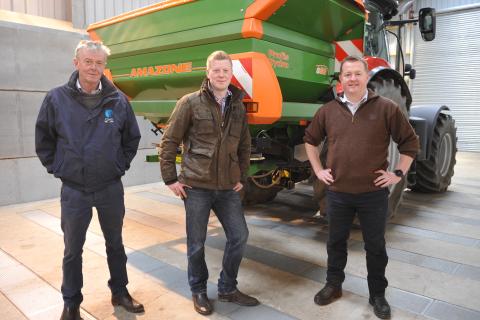10 May 2018
Soil nutrient mapping is allowing a Pembrokeshire arable and livestock farm to adjust its fertiliser application rate within a single field – targeting higher inputs on areas with a poor nutrient status and reducing inputs on those that don’t need it.
Dudwell Farm, a Farming Connect Focus Site at Camrose, trialed a new generation of technologies that provide farmers with information on nutrient variations in their soils.
In one field, sampling showed a huge range in the phosphorous level, from a low of -1 in some parts to a high of +3 in others while potash ranged from 0 to 3+. pH varied too – from 5.3 in some parts to 6.3 in others.
Traditionally, farmers have applied fertiliser at the same rate in a single field but, armed with this new information and using variable rate application technology, inputs can be targeted where they are needed.
Precision farming advisor Ian Beecher-Jones told farmers attending a Farming Connect event at Dudwell Farm that digital maps allowed virtual boundaries to be created within fields.
“Historically, fence lines were put in for a reason, they were there to enable parts of the farm with different soil types to be managed differently,’’ he said.
“Hedges have been removed over the years but soil mapping restores those hedges digitally and allows the fields to be managed as they once were but while taking into account the scale and economics of modern farming.’’
The cost of precision sampling ranges from £15 - £25/hectare and needs to be repeated every 3-5 years.
Although there is potential to reduce inputs in some areas and therefore make cost savings, this approach extends beyond this by allowing farmers to manage their land better, improve performance and reduce nutrient run-off into watercourses.
“We must optimise every kilogramme of fertiliser that goes onto a field, we shouldn’t be applying it to areas that can’t utilise it as this just ends up in watercourses and that has a consequential environmental impact,’’ said Mr Beecher-Jones.
“Also, if a farmer ends up using more fertiliser because their indices are low they will get better output from their system, whether that’s arable, dairy, beef or sheep.’’
Tom Rees, who farms Dudwell with his father, Charles, said the maps used in combination with new yield monitoring equipment the business had invested in this year would allow the fields to be managed more efficiently.
“What the soil mapping has basically done is put the old boundaries back in the fields but has also gone a step further, splitting parcels of land into even smaller areas according to nutrient status,’’ he said.
“Rather than working with a field of six or seven hectares we will now be managing that field in areas of one or one-and-a-half hectares.’’
The Rees family, who grow 450 acres of arable crops, will grow stubble turnips in one of the fields they had mapped and potatoes in the other. They plan to use digital soil sampling in all their fields in due course.
Delana Davies, Arable and Horticulture Technical Officer at Farming Connect, said the technology had particular relevance for use in fields next to watercourses.
“Agri pollution is a problem that farmers must deal with, this technology can allow them to do that,’’ she said.
“Any nutrients that are running off because a field doesn’t need them is money wasted so applying these in accordance with soil indices will not only be better for the environment but for farm costs too.’’
Farming Connect supports farmers with up to 100% funding for analysing their soils. By applying to the Farming Connect Advisory Service, individual farms can receive 80% funding or, if they apply as a group of three or more, there is 100% funding.
Click here for more information.
This project is co-ordinated by Farming Connect which is funded by the European Agricultural Fund for Rural Development and the Welsh Government.

